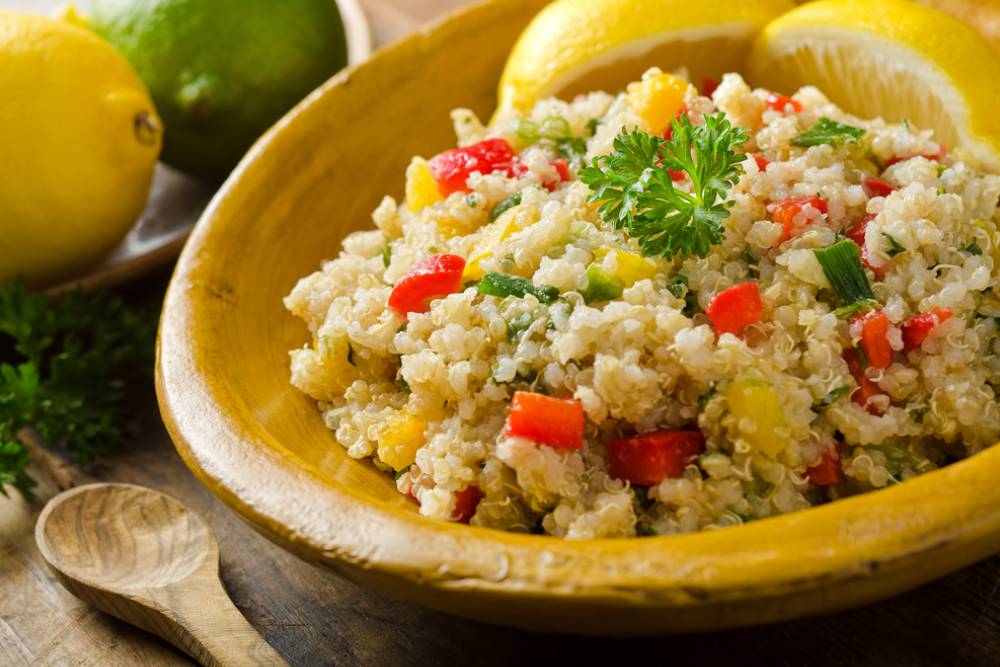Quinoa can become a great addition to your meal plan if you are trying to lose weight. The grain is not only packed with minerals and vitamins, but it also has a lot of fiber and slow-digesting carbs which means that a portion of quinoa will keep you feeling full for quite a while.
How much of this grain should you eat and when? And in what cases quinoa can actually do more harm than good?
Let’s find out!
How Much Quinoa Should I Eat a Day to Lose Weight?
Eating quinoa won’t directly cause weight loss. A calorie deficit is what will.
The good news is that one serving of quinoa has 4.4 grams of protein and 2.8 grams of fiber. Such a combo suppresses hunger, so it will be easier for you to limit your food intake during the day.
Moreover, the same amount of quinoa contains a little more than 170 calories. That is a lot less than in the majority of grains.
Some studies suggest that quinoa can also prevent weight gain by increasing energy expenditure.
By the way, a cup of this grain has over 50% of the daily recommended intake of manganese – a mineral that boosts metabolism, improves digestion, protects against abdominal obesity, and reduces the level of blood fats.
All in all, having 50 grams of quinoa per day would be just enough to get the most out of the grain. Combine quinoa with beans or put it in a salad to add a bit of variety to your menu.
Best Time to Eat Quinoa for Weight Loss
Quinoa should be eaten during the day (for breakfast or lunch).
The slow-digesting carbs will help you feel full throughout the day. Moreover, as our metabolism rate slows down towards the evening, it is better to consume foods that are high in fiber in the first part of the day to help our body properly digest the products.

Can Quinoa Help You Lose Belly Fat?
Eating 50 grams of quinoa per day will help significantly reduce serum triglyceride concentration.
HDL cholesterol and serum triglyceride concentrations are directly linked to an excess of abdominal fat. In fact, these things have a much stronger effect on belly fat than on the overall BMI.
Can I Eat Quinoa While Dieting?
As long as you are able to keep an eye on the calories, quinoa is a great food to have while dieting.
The grain is packed with minerals and vitamins. A cup of cooked quinoa has:
- 19% of the daily value of folate
- 13% of vitamin B6
- 8% of vitamin E
- 39% of copper
- 15% of iron
- 18% of zinc
- 51% of manganese
- 28% of magnesium
- 7% of potassium
- 22% of phosphorus
It is quite challenging to continue to consume the appropriate amount of minerals and vitamins with your meals when you are on a strict diet. Quinoa is one of those foods that will help make sure that you stay healthy while you’re on your weight-losing journey.
Moreover, the grain has plenty of fiber (5 grams per cup of cooked grain) and slow-digesting carbs, so a relatively small amount of quinoa will keep you feeling full for longer (which is also a great thing, when you are trying to stick to a strict diet).
Foods that are high in fiber help support your proper body weight by promoting bowel movements and ‘feeding’ the good bacteria in the gut.
Finally, quinoa is a grain that can help you meet your daily protein needs. People who are following a strict diet often forget about how important protein is; they simply focus on cutting down the calorie intake.
For every pound of body weight, you should be having 0.36 grams of protein in order to stay healthy. A cup of quinoa will provide you with 8 grams.
What Is Better for Weight Loss, Brown Rice vs Quinoa?
While you’re dieting, you can eat practically anything you want. As long as you have a calorie deficit, you will lose weight.
Both brown rice and quinoa are naturally gluten-free and high in fiber. However, when it comes to nutritional value, quinoa has a bit more goodness to offer.
Quinoa has 8 grams of protein per cup, while brown rice has 4-5 grams. By the way, quinoa also contains all nine essential amino acids and rice has only a few.
Even though brown rice is packed with nutrients as well, quinoa has more copper, zin, and calcium and, overall, is 3-4 times richer in nutrients than rice.
Finally, quinoa is a better option for you, if you have chosen to follow a low-carb diet. This grain has 39 grams of carbohydrates per cup, while brown rice has 45 grams.
You can use our tdee calculator to see how much you should eat to lose weight.
Is Quinoa Bad for You?
Quinoa is bad for people who are allergic to the grain or saponin (a compound found in the coating of quinoa seeds).
Some of the symptoms of an allergic reaction include:
- Itchiness
- Coughing
- Tightness in chest
- Nausea
- Vomiting
- Stomach pain
- Inflammation in the lungs and digestive tract
Unfortunately, there are individuals who can experience a severe allergic reaction which can be followed by an elevated heart rate, facial swelling, and even inability to breathe.
To remove the natural coating and the saponin (the main ‘reason’ for the development of allergies), you can try soaking quinoa in water for 30 minutes and then rinsing it several times.


